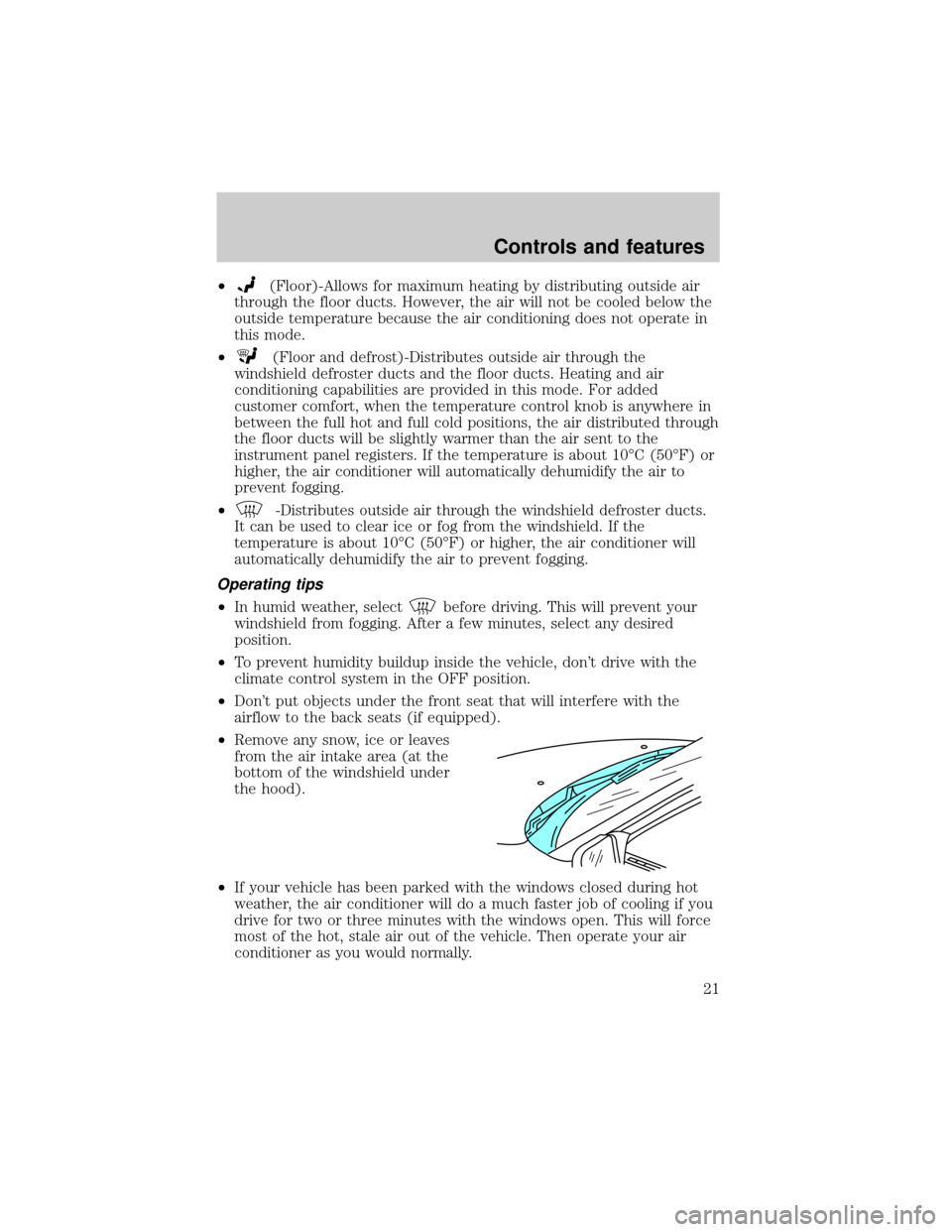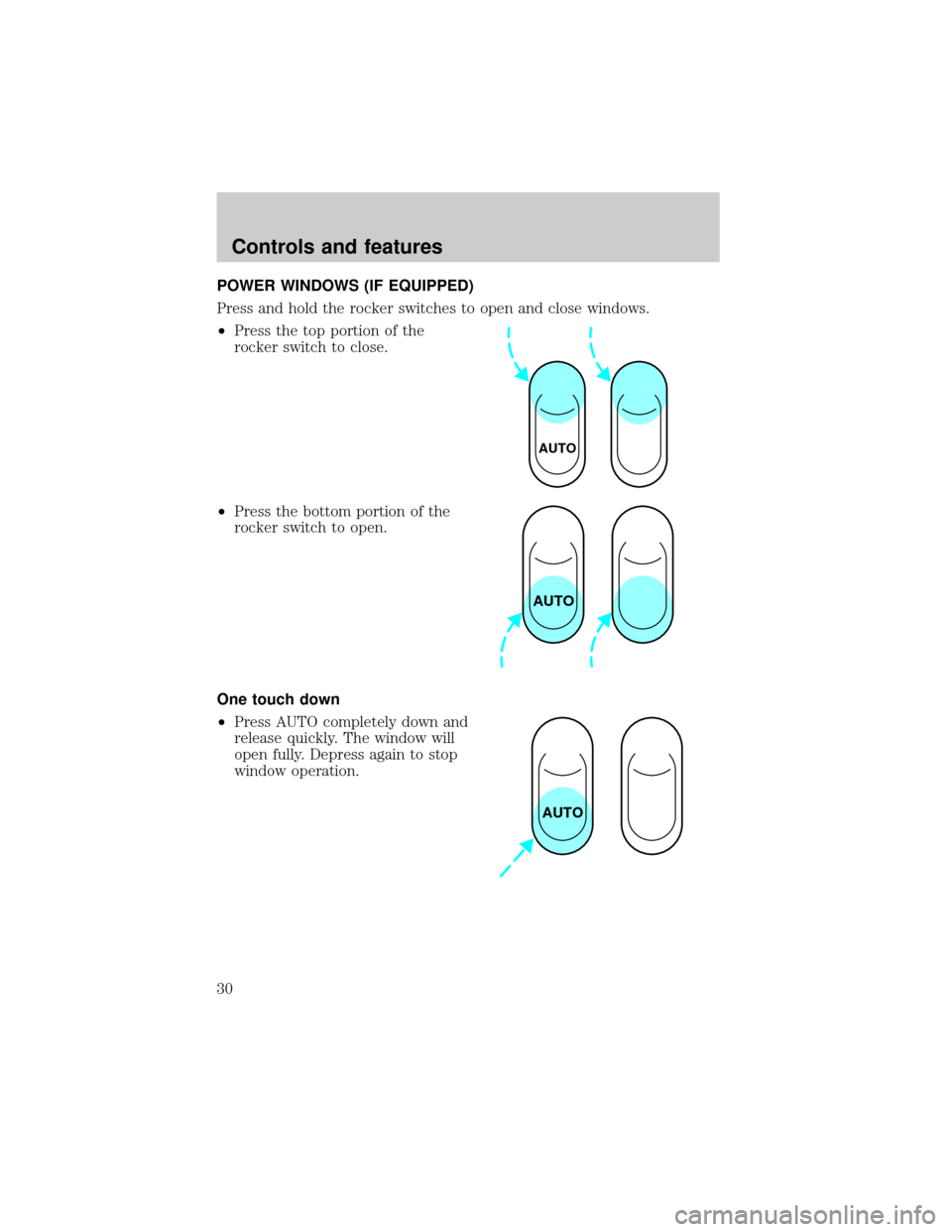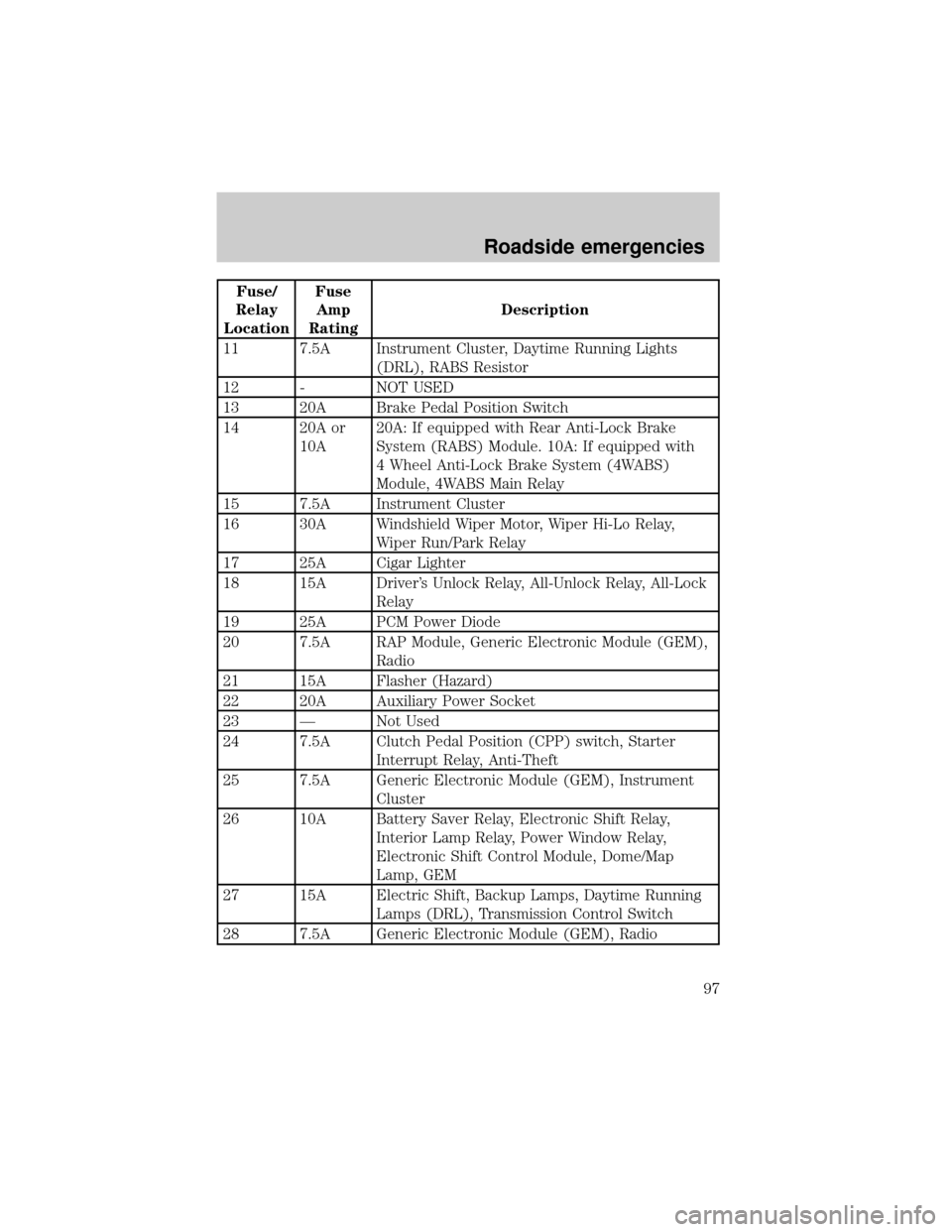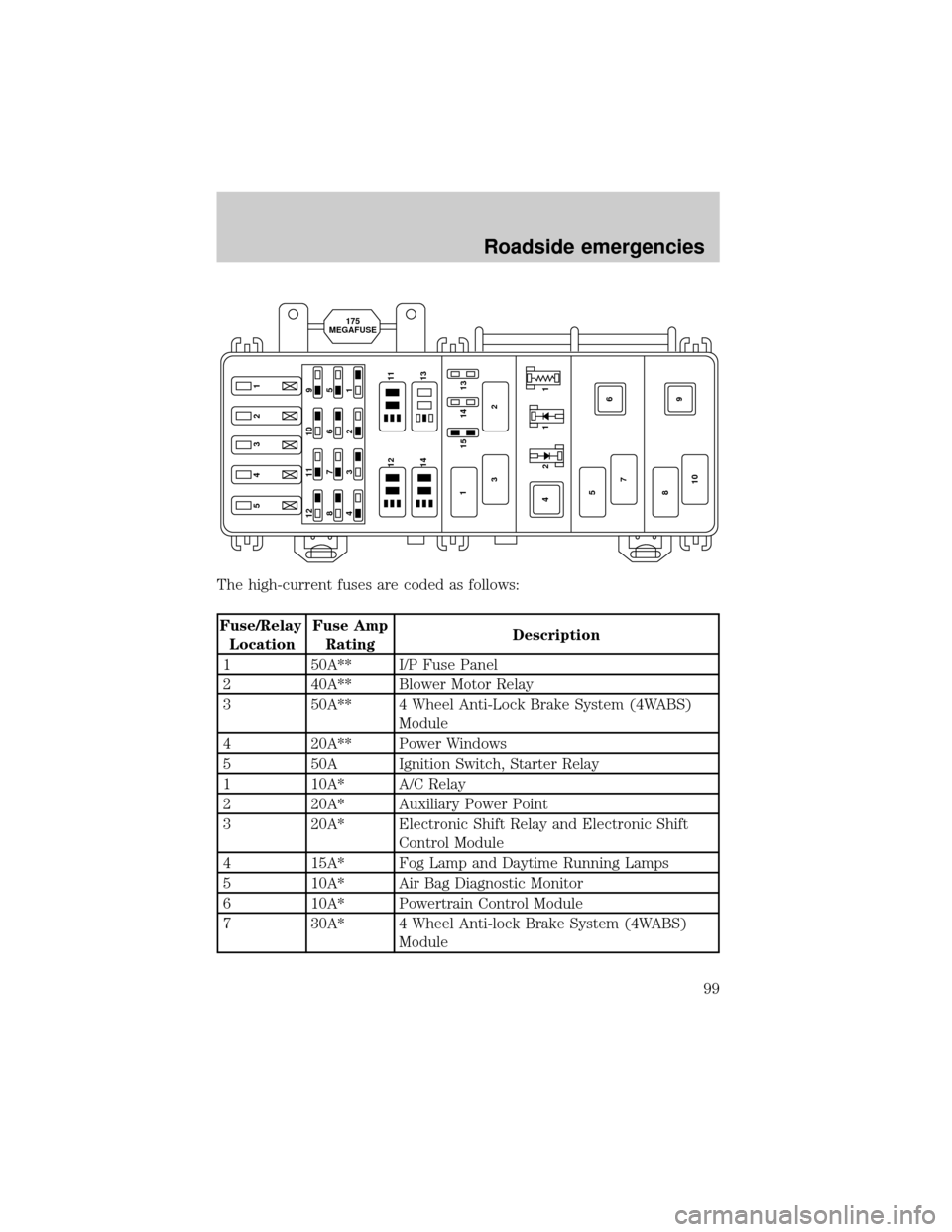window FORD RANGER 1998 2.G Owners Manual
[x] Cancel search | Manufacturer: FORD, Model Year: 1998, Model line: RANGER, Model: FORD RANGER 1998 2.GPages: 160, PDF Size: 1.38 MB
Page 21 of 160

²(Floor)-Allows for maximum heating by distributing outside air
through the floor ducts. However, the air will not be cooled below the
outside temperature because the air conditioning does not operate in
this mode.
²
(Floor and defrost)-Distributes outside air through the
windshield defroster ducts and the floor ducts. Heating and air
conditioning capabilities are provided in this mode. For added
customer comfort, when the temperature control knob is anywhere in
between the full hot and full cold positions, the air distributed through
the floor ducts will be slightly warmer than the air sent to the
instrument panel registers. If the temperature is about 10ÉC (50ÉF) or
higher, the air conditioner will automatically dehumidify the air to
prevent fogging.
²
-Distributes outside air through the windshield defroster ducts.
It can be used to clear ice or fog from the windshield. If the
temperature is about 10ÉC (50ÉF) or higher, the air conditioner will
automatically dehumidify the air to prevent fogging.
Operating tips
²In humid weather, selectbefore driving. This will prevent your
windshield from fogging. After a few minutes, select any desired
position.
²To prevent humidity buildup inside the vehicle, don't drive with the
climate control system in the OFF position.
²Don't put objects under the front seat that will interfere with the
airflow to the back seats (if equipped).
²Remove any snow, ice or leaves
from the air intake area (at the
bottom of the windshield under
the hood).
²If your vehicle has been parked with the windows closed during hot
weather, the air conditioner will do a much faster job of cooling if you
drive for two or three minutes with the windows open. This will force
most of the hot, stale air out of the vehicle. Then operate your air
conditioner as you would normally.
Controls and features
21
Page 30 of 160

POWER WINDOWS (IF EQUIPPED)
Press and hold the rocker switches to open and close windows.
²Press the top portion of the
rocker switch to close.
²Press the bottom portion of the
rocker switch to open.
One touch down
²Press AUTO completely down and
release quickly. The window will
open fully. Depress again to stop
window operation.
AUTO
AUTO
AUTO
Controls and features
30
Page 63 of 160

Guarding against exhaust fumes
Although odorless and colorless, carbon monoxide is present in exhaust
fumes. Take precautions to avoid its dangerous effects.
If you ever smell exhaust fumes of any kind inside your vehicle,
have your dealer inspect and fix your vehicle immediately. Do
not drive if you smell exhaust fumes. These fumes are harmful and
could kill you.
Have the exhaust and body ventilation systems checked whenever:
²the vehicle is raised for service.
²the sound of the exhaust system changes.
²the vehicle has been damaged in a collision.
Important ventilating information
If the engine is idling while the vehicle is stopped in an open area for
long periods of time, open the windows at least 2.5 cm (one inch).
Adjust the heating or air conditioning (if equipped) to bring in fresh air.
Improve vehicle ventilation by
keeping all air inlet vents clear of
snow, leaves and other debris.
Starting
63
Page 97 of 160

Fuse/
Relay
LocationFuse
Amp
RatingDescription
11 7.5A Instrument Cluster, Daytime Running Lights
(DRL), RABS Resistor
12 - NOT USED
13 20A Brake Pedal Position Switch
14 20A or
10A20A: If equipped with Rear Anti-Lock Brake
System (RABS) Module. 10A: If equipped with
4 Wheel Anti-Lock Brake System (4WABS)
Module, 4WABS Main Relay
15 7.5A Instrument Cluster
16 30A Windshield Wiper Motor, Wiper Hi-Lo Relay,
Wiper Run/Park Relay
17 25A Cigar Lighter
18 15A Driver's Unlock Relay, All-Unlock Relay, All-Lock
Relay
19 25A PCM Power Diode
20 7.5A RAP Module, Generic Electronic Module (GEM),
Radio
21 15A Flasher (Hazard)
22 20A Auxiliary Power Socket
23 Ð Not Used
24 7.5A Clutch Pedal Position (CPP) switch, Starter
Interrupt Relay, Anti-Theft
25 7.5A Generic Electronic Module (GEM), Instrument
Cluster
26 10A Battery Saver Relay, Electronic Shift Relay,
Interior Lamp Relay, Power Window Relay,
Electronic Shift Control Module, Dome/Map
Lamp, GEM
27 15A Electric Shift, Backup Lamps, Daytime Running
Lamps (DRL), Transmission Control Switch
28 7.5A Generic Electronic Module (GEM), Radio
Roadside emergencies
97
Page 99 of 160

The high-current fuses are coded as follows:
Fuse/Relay
LocationFuse Amp
RatingDescription
1 50A** I/P Fuse Panel
2 40A** Blower Motor Relay
3 50A** 4 Wheel Anti-Lock Brake System (4WABS)
Module
4 20A** Power Windows
5 50A Ignition Switch, Starter Relay
1 10A* A/C Relay
2 20A* Auxiliary Power Point
3 20A* Electronic Shift Relay and Electronic Shift
Control Module
4 15A* Fog Lamp and Daytime Running Lamps
5 10A* Air Bag Diagnostic Monitor
6 10A* Powertrain Control Module
7 30A* 4 Wheel Anti-lock Brake System (4WABS)
Module
5432112 11 10 9
876 5
432 1
14 15 13
9 6
10 87 5 41
2 3
211
175
MEGAFUSE
11
13 12
14
Roadside emergencies
99
Page 146 of 160

Cleaning the instrument panel
Clean with a damp cloth, then dry with a dry cloth.
Avoid cleaner or polish that increases the gloss of the upper portion of
the instrument panel. The dull finish in this area helps protect the driver
from undesirable windshield reflection.
Cleaning the interior fabric
Remove dust and loose dirt with a whisk broom or a vacuum cleaner.
Remove fresh spots immediately. Follow the directions that come with
the cleaner.
Cleaning and maintaining the safety belts
Clean the safety belts with a mild soap solution recommended for
cleaning upholstery or carpets. Do not bleach or dye the belts, because
these actions may weaken the belt webbing.
Check the safety belt system periodically to make sure there are no
nicks, wear or cuts. If your vehicle has been involved in an accident,
refer to theSafety belt maintenancesection in theSeating and safety
restraintschapter.
Underbody
Flush the complete underside of vehicle frequently. Keep body drain
holes unplugged. Inspect for road damage.
Inside windows
Use glass cleaner for the inside windows if they become fogged.
Cleaning mirrors
Do not clean your mirrors with a dry cloth or abrasive materials. Use a
soft cloth and mild detergent and water. Be careful when removing ice
from outside mirrors because you may damage the reflective surface.
Maintenance and care
146
Page 156 of 160

Aiming headlamps ....................142
Air bag supplemental restraint
system ..........................................47
and child safety seats ..............48
description ................................47
disposal ......................................50
indicator light ...........................50
passenger air bag ...........48,51,52
Air conditioning
manual heating and air
conditioning system .......19,20,21
Ambulance packages ....................3
Anti-lock brake system (ABS)
description ................................66
Anti-theft system ........................35
Battery .......................................128
voltage gauge ............................15
Brake fluid
checking and adding ..............118
Brakes ..........................................64
anti-lock ................................64,65
anti-lock brake system (ABS)
warning light .............................66
fluid, checking and adding ....118
Brake-shift interlock ...................67
Break-in period .............................2
Bulbs, replacing ........................139
headlamps ...............................140
specifications ..........................141
Changing a tire .........................101
Child safety seats ........................54
Chime
headlamps on ............................11
Cleaning your vehicle ...............142
engine compartment ..............143
fabric ........................................146
instrument panel ....................146
plastic parts ............................145
safety belts ..............................146
tail lamps .................................145
washing ....................................142
waxing .....................................143wheels ......................................143
windows ..................................146
Clutch
fluid ..........................................119
Controls ..................................23,31
Driving under special
conditions ....................................77
high water .................................78
slippery roads ......................78,79
Emission control system ..........138
Engine ........................................151
service points ............112,113,114
Engine block heater ...................62
Engine coolant
checking and adding ..............121
disposal ....................................122
refill capacities ........................123
Engine oil ...........................115,117
changing oil and oil filter .......118
checking and adding .......115,117
Exhaust fumes ............................63
Foglamps .....................................16
Four-Wheel Drive vehicles .........74
control trac ..........................22,75
indicator light ...........................75
Fuel
calculating fuel economy .......137
improving fuel economy ..........92
octane rating ...........................136
quality ......................................136
running out of fuel .................137
safety information relating
to automotive fuels ................135
Fuel gauge ...................................12
Fuel pump shut-off switch .........93
Fuse panels
instrument panel ......................95
power distribution box .............98
Fuses .......................................94,95
Gauges, Mechanical
engine coolant temperature
gauge .........................................13
Index
156
Page 158 of 160

canceling a set speed ...............27
indicator light ...........................28
resuming a set speed ...............28
tap up/tap down .......................26
turning off .................................25
Speedometer ...............................14
Starting your vehicle .............59,61
Tachometer
mechanical cluster ...................13
Tilt steering wheel ......................29
Tires ....................................130,132
changing ..................................103
checking the pressure ............132
replacing ..................................133
rotating ....................................132
snow tires and chains ............134
treadwear ................................131
Traction-lok rear axle ..........79,127
Trailer towing ..............................81
tips .............................................89
Transaxle
fluid, checking and adding
(manual) .................................126
Transfer case
fluid checking .........................127Transmission .............................124
automatic
operation ..........67,68,69,70,71,72
fluid, checking and adding
(automatic) .............................124
Trip odometer .............................14
Turn signal
lever ...........................................24
Vehicle dimensions ...................152
Vehicle Identification Number
(VIN) ..........................................154
Vehicle loading ............................79
Ventilating your vehicle .............63
Windows
power windows, operating .......30
Windshield washer fluid and
wipers
checking and adding fluid .....120
checking and replacing wiper
blades ......................................129
operation ...................................29
Wrecker towing .........................109
Index
158